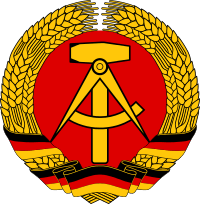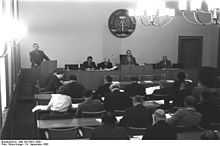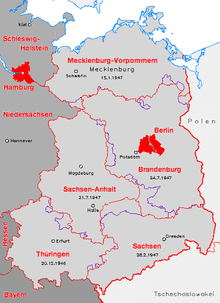Chamber of States
| Chamber of States Länderkammer | |
|---|---|
| German Democratic Republic (East Germany) | |
 | |
| Type | |
| Type |
Upper House |
| History | |
| Established | 1949 |
| Disbanded | 1958 |
| Preceded by | People's Chamber (Volkskammer) |
| Succeeded by | People's Chamber |
| Seats | 50 |
The Chamber of States (German: Länderkammer) was one of the two legislative chambers of the German Democratic Republic (East Germany) from its founding in 1949 until 1952, at which time it was largely sidelined, when the five Länder (states) of East Germany were abolished and replaced with smaller administrative regions. The Chamber of States itself was abolished on 8 December 1958. The other chamber, which continued in existence until German reunification in 1990, was the People's Chamber (Volkskammer).
In the Federal Republic of Germany the expression Länderkammer is sometimes used to denote the Bundesrat although it is not considered to be a parliament chamber.

Idea and reality

After 1945, the Soviet military administration established the five Länder of Mecklenburg-Vorpommern, Brandenburg, Saxony, Saxony-Anhalt and Thuringia.
Initially, in 1949, the communists aimed for a quasi-unitary state, with some degree of decentralisation. Laws were to be made by the central legislature in East Berlin, and the Land authorities were responsible for the implementation of the laws.
In practice, due to the democratic centralism of the SED, the GDR rapidly developed strong centralist tendencies. However, it initially operated in this bicameral framework in which the states were represented. The Chamber of States theoretically had the power to introduce bills and to veto laws proposed by the People's Chamber, although another vote in the People's Chamber could overturn such a veto. The Chamber of States never made use of its veto.
According to the Constitution of East Germany, in addition to the People's Chamber, a “provisional Land Chamber” was formed. The fifty members of the Land Chamber were to be determined by the assemblies in the various Länder, according to the memberships of these assemblies. Saxony sent 13 delegates, Saxony-Anhalt and Thuringia 10 each, Brandenburg nine, and Mecklenburg-Vorpommern seven. East Berlin sent 13 delegates, but they did not have voting rights owing to Berlin as a whole still legally being occupied territory. (A similar arrangement existed in West Berlin, in which the city's delegates in the Bundestag and Bundesrat had no voting rights.)
In 1952, the East German Länder were abolished. The Chamber of States remained in existence, but became increasingly redundant. Since the Landtage could no longer meet to elect members of the Chamber of States, the 1954 delegates for each Land were chosen by a special meeting of the District Assemblies (Bezirkstage) of that state. The members of the Chamber of States elected in 1958 were directly elected by their Bezirkstage. These delegates were appointed as a "suicide squad," raising no objection as the People's Chamber abolished the Chamber of States on 8 December 1958.
Presidents of the Chamber of States
| Name | Period | Party |
|---|---|---|
| Reinhold Lobedanz | October 11, 1949 – March 5, 1955 | CDU |
| August Bach | 1955 – December 8, 1958 | CDU |
Vice-Presidents of the Chamber of States
| Name | Period | Party |
|---|---|---|
| August Fröhlich | 1950 – 1958 | SED |
| Hans Luthardt | 1950 – 1958 | NDPD |
| Erich Hagemeier | 1950 - 1954 | LDPD |
| Dr. Karl Mühlmann | 1954 - 1958 | LDPD |
| Max Suhrbier | 1958 | LDPD |
| Diedrich Besler | 1950 - 1954 | DBD |
| Albert Rödiger | 1954 - 1958 | DBD |
See also
- Administrative divisions of the German Democratic Republic
- Politics of East Germany